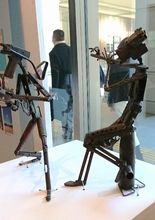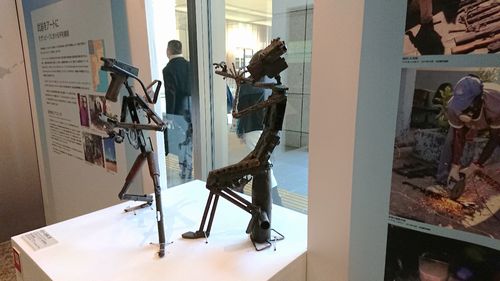Exhibition at the Entrance of the Ministry of Education, Culture, Sports, Science and Technology: “Turning Weapons into Art: Peacebuilding Efforts in Mozambique, Africa”

National Institutes for the Humanities
The Ministry of Education, Culture, Sports, Science and Technology (MEXT) is utilizing space within the ministry building for publicity purposes to present the findings and distinctive endeavors of universities and research institutions in Japan. Projects selected from public and private universities, research institutes, and other organizations are on exhibit at the MEXT main entrance where they can be seen by visitors and passersby.
In this issue, we introduce an MEXT entrance exhibition that was held from January to February 2020.
“National Museum of Ethnology ‘Transforming Arms into Art: Peace-building in Mozambique’”
(Exhibition Period: January 7 – February 10, 2020)
After gaining independence from Portuguese rule, Southeast African nation Mozambique endured a civil war that lasted from 1975 until 1992, after which a massive number of weapons were left to the hands of the general public. Currently a project called TAE (Transformação de Armas em Enxadas/Transforming Arms into Plowshares) is ongoing in the country: an initiative to collect weaponry, swapping it for farming equipment. This initiative aims not only to promote disarmament but also to utilize the accumulated firearms to create works of art, in turn establishing peace among peoples. TAE has been attracting attention as a model for building peace after civil wars.
As part of this project, artists Fiel dos Santos and Cristovao Canhavato (Kester) produced four sculptures that embody their messages to the people in Japan. These works have been added to the National Museum of Ethnology’s (Minpaku) collection, and three of them are on display in the MEXT exhibition space (“Armchair,” “Man Playing a Flute,” and “Man Playing a Guitar”).

The works on display at the MEXT main entrance,
a particularly busy area of the ministry building.
None of the weapons of which the sculptures were fashioned were manufactured in Africa. Arms from other parts of the world were used in the Mozambican Civil War, and many of them are still buried in the nation’s soil.
A monitor screen at the exhibition space showed footage of interviews with people who—through the project—parted with their weapons, encouraging viewers to reflect deeply upon peace.
The exhibition seems to have served as an opportunity for visitors to take a fresh look at the significance and potential of peacebuilding through art and museum-led activities.
“Are these real guns?”
While the exhibition was open, organizers invited Kenji Yoshida, Director-General of Minpaku, to hold a public talk under the title “Turning Weapons into Art: Peace-building Efforts in Mozambique, Africa.” This event, which was attended by many people, proved a lively session. Participants enthusiastically shared their views and made suggestions for topics, such as “comparing how weapons are perceived in the West and Japan” and “ensuring replacements for weapons.”
Scene from the public talk
The National Institutes for the Humanities (NIHU) study peoples’ cultural activities and the relationship between humankind, society, and nature. NIHU needs to question society about the true meaning of affluence, and repeatedly encourage interaction between society and the actual work of research. Continued efforts will be made by NIHU to host various events each year to promote general and research-related public relations activities. At the same time, NIHU will promote the circulation of humanities-related knowledge by carrying out an organizational project to train “Liberal Arts Communicators”, striving to achieve “mutual transmission of information.”
[Related links] vol.045 – Exhibition at the Entrance of the Ministry of Education, Culture, Sports, Science and Technology: “Visitor Collaboration-based Global Environment Poster Exhibition”
